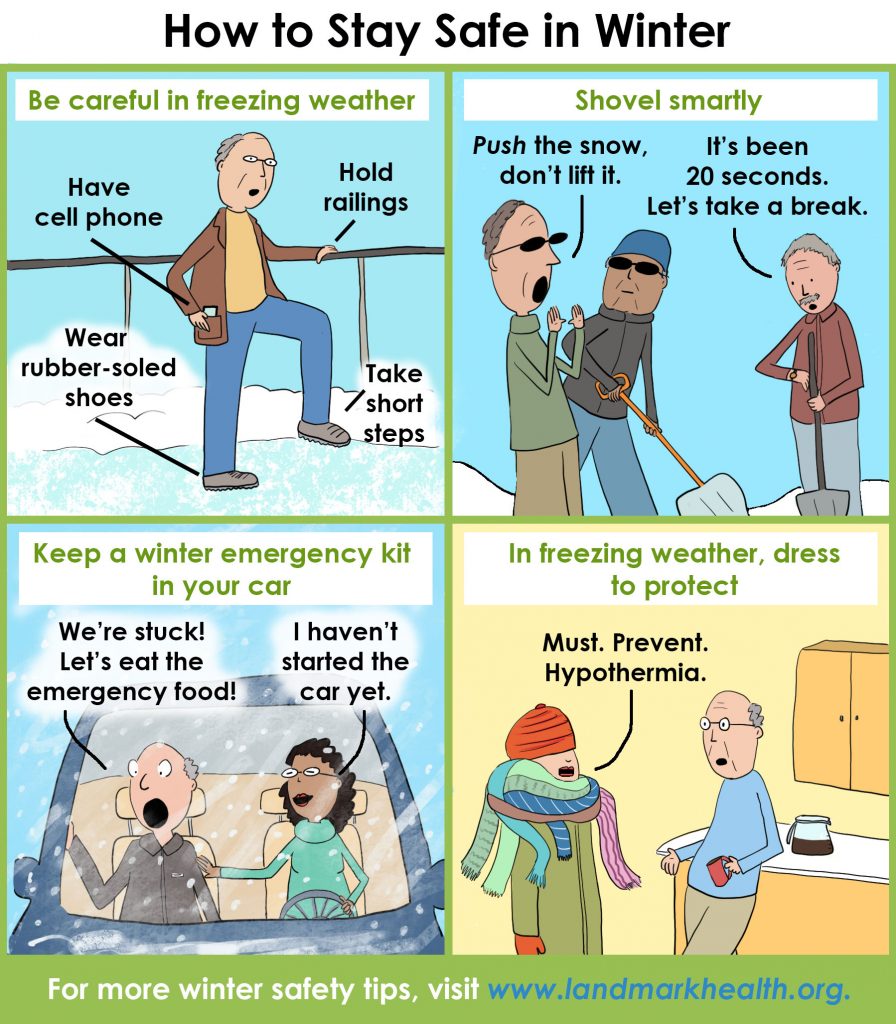
Blog post
Prioritizing Mental Health as a Universal Human Right
By: Neltada Charlemagne, DNP, APRN, PMHNP-BC, PHN, BHC
Learn how to enjoy the winter season, while minimizing the risk of injury.
Winter can be a fun and beautiful time of the year, but preventing wintertime injuries can be a challenge. Read on to learn about common risks of injury during cold weather, and how you can prevent getting hurt.

Slips and Falls
Slippery sidewalks on icy days are a problem for everyone, regardless of age or health status. However, falls can pose an increased risk of serious injury for older people and those with health issues. According to the CDC, falls are the leading cause of injury among older adults.
Common injuries from falling on ice include:
The easiest way to avoid injuries during the winter is to stay inside until your walkways have been shoveled and cleared of ice. When you do need to leave the house, take these precautions to reduce your risk of falls and injury:
Remember—ice can be hard to see. What looks like water on the sidewalk can sometimes be slick ice.
If you are a Landmark patient and have fallen and have pain or swelling, call Landmark right away. It’s a good idea to call Landmark even if you don’t feel you have a severe injury.
Shoveling Injuries
Shoveling snow is a risky activity for older adults because it has the potential to cause serious injury, trigger back pain, or cause you to slip and fall. In some individuals, shoveling can even trigger a heart attack or stroke. People over 55 years of age are 4 times more likely than younger adults to have a heart problem while they are shoveling snow. Each year in the U.S., thousands of ER visits are made due to snow shoveling injuries.
Those with heart problems, diabetes, or high blood pressure should probably have another person do the shoveling. Shoveling can trigger a stroke or heart attack in certain individuals.
If you must shovel snow and are physically able, be sure to wear proper clothing and footwear, take frequent breaks, use your legs to move the snow (not your back), and push the snow rather than lifting it. Stop immediately if you start feeling sick or short of breath. It’s easy to overestimate how much shoveling you can do. Shoveling is a strenuous activity, and it is easy to hurt your back or pull muscles.
To reduce physical strain of shoveling, consider investing in a snowblower—but remember that snowblowers can cause injuries too. In particular, the blades of the snow blowing machine are sharp, even when they’re not moving. Never stick your hand into the machine, and remember that the blades still turn for a while after the machine is turned off.
Getting Stuck in Your Car During Snowstorms
If you must drive when it’s snowing or very cold, be sure to keep an emergency kit in your car. If you get stuck on the side of the road, hypothermia is a risk. Hypothermia risk is greater for older adults, who are less able to regulate their body temperature. If you get wet for any reason, you will lose body heat even faster.
Your winter emergency kit should include items such as a cellphone charger, blankets, bag of sand, flashlight, food, water, and first aid kit. The CDC provides complete information on what to include in your car emergency kit.
Hypothermia and Frostbite
During cold weather, the body loses heat faster than it can produce it. Long exposure to the cold can cause hypothermia. Keep your house at a comfortable temperature, limit outdoor time in freezing temperatures, dress in layers and protect exposed skin with winter outerwear. Be sure to stay dry and remove wet clothing right away.
Frostbite is also a risk in the winter, especially when the temperature is below zero. Frostbite can take hold as quickly as within five minutes and can cause permanent damage if body tissues freeze all the way through.
Keep safety in mind this winter. Enjoy the season, while minimizing the risk of injury.
References:
https://www.summitmedicalgroup.com/news/living-well/how-prevent-winter-injuries/
https://www.doctoroz.com/article/preventing-winter-injuries
https://www.cdc.gov/media/releases/2016/p0922-older-adult-falls.html

By: Neltada Charlemagne, DNP, APRN, PMHNP-BC, PHN, BHC

Older adults can safeguard themselves from the physical, mental and emotional toll of unexpected medical costs.

Optum Care Network – Monarch has teamed up with Landmark to deliver in-home medical care to members with multiple chronic conditions.